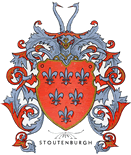From a collection of articles pertaining to Stoutenburgh lands we present the following:
Home of Jacobus Stoutenburgh of Hyde Park, NY
By Maud Stoutenburgh-Eliot
September 22, 1935: The name Jacobus Stoutenburgh appears on the tax list in 1741 when his Dutch manor house of stone was completed.
The house faced both east and west with its south wall exactly on the present northerly fence line of Cecil Parker’s triangular lot at the corner of Park Place and Market Street directly opposite the entrance to the home of Mr. Edward H. Wales, the site of whose present gateway was occupied by the servants quarters. It was a large house and extended across the present market street for fifty feet. Market Street was the avenue cut by Judge Stoutenburgh from the Albany Post Road, for the entrance driveway to his residence and he planted cherry trees on both sides of it for the whole distance. Very shortly afterward, he and his son-in-law, Maj. Richard De Cantillon (1) still further extended it down the hill to the river where they built a dock and boat landing known for a century or more as De Cantillon and Stoutenburg’s Landing.
This Stoutenburgh manor house, being a conspicuous object visible from the river for a long distance and known to be the home of a family of uncompromising patriots, was the target of British gun boat bombardment on their way to burn Kingston. Fortunately, the elevation of the British smooth-boats was insufficient to do much more damage than to put one twenty-four pound cannonball through the lower panel of the westerly Dutch door, graze the floor and exit the opposite Dutch door into a sand bank just beyond. Another shot by the same gun missed the house by a hair and landed nearby. One smaller six pound shot was equally unsuccessful and with the other two was recovered and kept as trophies by the family. The first mention of them is in the possession of Mrs. Walter G. Eliot (Maud Stoutenburgh) and was preserved by the descendants of Jacobus Stoutenburgh in one spot not more than 200 feet from where it fell in 1777 until 1909 when Mrs. Eliot inherited it along with the smaller one. The other is still somewhere in Hyde Park or in Poughkeepsie owned by a collateral relative. (2) The same sand bank has yielded many more of the smaller shot now scattered among the local people.
The second stone dwelling house built in Hyde Park appears to have been that erected for John Stoutenburgh, son of Jacobus, in 1751, on the east side of the post road and yet well preserved, standing just below the “Lower Landing Road” which bounds the northerly end of Col. Archibald Rogers’ homestead grounds. The preservation, in it’s present picturesque state, of this historical memento of the Revolution is a fine tribute to the intelligence and patriotism of Colonel Rogers, one of the outstanding citizens of distinction in Hyde Park. Both of these houses were the frequent stopping places for officers of Washington’s army during the troop movements of the revolutionary days and were the frequent rendezvous of patriot, military and citizens committees.
John Stoutenburgh died without issue, having freed his slaves by will and built the stone wall around the Stoutenburgh cemetery now surrounded by the Vanderbilt lands. His brother William built, in 1764, the stone house on the Creek Road (now a state highway), yet standing just south of Union Corners and nearly opposite the new cemetery. It was to this house that Jacobus and his family fled temporarily for safety during the bombardment of the manor house and it was here that William lived until his death.
In deeds and documents Jacobus appears as of New York, as of Westchester County and finally as of Dutchess County. He is termed as merchant, bolter, farmer, yeoman, gentleman and judge. There hangs at the Beekman Arms a court order giving the judge as Jacobus Stoutenburgh.
Notes:
- Richard De Cantillon was Tobias Stoutenburgh’s son-in-law. Tobias was Jacobus Stoutenburgh’s eldest son. The first landing was built before 1742 and was called the Lower Landing. This landing was destroyed in 1777 by the British. Jacobus’ third son, Jacobus, rebuilt the landing, while Tobias built a new landing south of Crum Elbow Creek. Richard De Cantillon and James T. Stoutenburgh, Tobias’ son conducted business from this landing, known as the De Cantillon – Stoutenburgh Landing. Their business included shipping, milling, distilling, tanning and merchandizing. (Source: “Docks That Once Operated at Hyde Park’s River Front,” Harry T. Briggs, 1954, Town of Hyde Park Historical Society.)
- One of the cannonballs is in the possession of Harry Ridgeway.



